A new twist on an old title: Supergirl and the Legion of Super-Heroes
By Graig
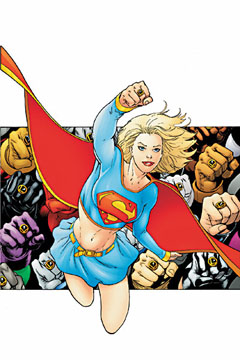 If it seems like Mark Waid and Barry Kitson’s revamp of the Legion to this point has been all too political and militaristic and less good-time superheroics, well, perhaps Waid and Kitson felt that way too. This isn’t to say that politics and warfare can’t make for entertaining tights-n-powers books, because the preceding issues were some of the most exciting and entertaining comics of 2005. But, when you have “Super-Heroes” in your title one might expect something more… conventional. Spandex good guys beating spandex bad guys up, saving people in distress, protecting the innocent, defending the weak, feats of strength… innocent, fun, high-spirited nonsense.
If it seems like Mark Waid and Barry Kitson’s revamp of the Legion to this point has been all too political and militaristic and less good-time superheroics, well, perhaps Waid and Kitson felt that way too. This isn’t to say that politics and warfare can’t make for entertaining tights-n-powers books, because the preceding issues were some of the most exciting and entertaining comics of 2005. But, when you have “Super-Heroes” in your title one might expect something more… conventional. Spandex good guys beating spandex bad guys up, saving people in distress, protecting the innocent, defending the weak, feats of strength… innocent, fun, high-spirited nonsense.
With issue sixteen of the series, the book changes its name to Supergirl and the Legion of Super-Heroes, and for some reason I’m giddy about the whole thing. I’m not a Legion history buff, but most long-time comic fans at least know of the late-1970’s title Superboy and the Legion of Super-Heroes, so this title shift brings with it the context of a whole different era of super-heroics, with a feminine Kryptonian twist.
In this issue (touted as “1001 years later” which I assume is in reference to Supergirl being one year later plus a thousand years, but seeing as this issue picks up almost immediately after the last Legion issue, that would actually only put it at 999 years, unless it’s 2 years before Supergirl arrived in modern time and… ach, nevermind) the kids of the Legion flex their new muscles as a free and independent legal authority. The seeds of abuse of their new power are already planted, but new drama unfolds as an asteroid barrels towards the Earth. In an impressive display of various members powers (and cool outer space sequence to boot) the Legion gives it their all, but a (not so) surprise stranger arrives to save the day. Yeah it’s Supergirl, a thousand(ish) years in the future and relatively unfazed by her new environment, because she has a shocking secret to reveal to her new friends.
I don’t know anything about this new Supergirl, aside from the fact that I hate her costume, which is a gaudy blending of the classic Helen Slater movie and now dated Superman Animated series garbs. Regardless, I’m looking forward to discovering what brings Supergirl to the future and watching the truth unfold before both her and the team. This is going to be fun.
RATING: 
Daredevil is in jail—and his troubles are just beginning!
By Jeb D.
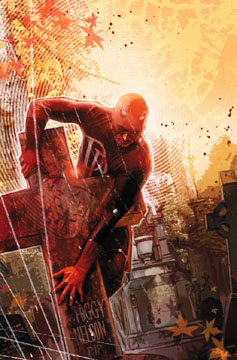 Given that he wrote some relatively low-profile (i.e., poor-selling) titles at DC, it’s interesting (and encouraging) that Marvel has had no qualms about giving Ed Brubaker the chance to work on some of their most visible characters. He’s been knocking Captain America out of the park for over a year now, with no sign of letup, he’s about to take over a core X-Men book, and he and Michael Lark have taken the handoff of Daredevil’s billyclub from Brian Bendis and Alex Maleev with nary a misstep. Bendis has said that he’d never have dared to leave Daredevil where he did at the end of his run (in prison) if he hadn’t been comfortable that the next writer could work with that story; Brubaker is not just working with it, in just two issues, he’s made that situation seem absolutely inevitable.
Given that he wrote some relatively low-profile (i.e., poor-selling) titles at DC, it’s interesting (and encouraging) that Marvel has had no qualms about giving Ed Brubaker the chance to work on some of their most visible characters. He’s been knocking Captain America out of the park for over a year now, with no sign of letup, he’s about to take over a core X-Men book, and he and Michael Lark have taken the handoff of Daredevil’s billyclub from Brian Bendis and Alex Maleev with nary a misstep. Bendis has said that he’d never have dared to leave Daredevil where he did at the end of his run (in prison) if he hadn’t been comfortable that the next writer could work with that story; Brubaker is not just working with it, in just two issues, he’s made that situation seem absolutely inevitable.
Matt Murdock’s in prison. The Federal agents responsible for this are never explicit about the crimes he’s accused of, but at their core is the fact that he’s been acting as a costumed vigilante while at the same time serving as an officer of the court—upholding the legal system by day, subverting it by night. He’s locked up with the vilest, most dangerous, of his enemies, and unafraid to let them know that it’s their misfortune, not his.
But Matt’s near a breaking point. At the conclusion of issue #82, the team’s debut, Matt had to listen from his cell as his partner and best friend Foggy Nelson suffered a horrendous knife attack, with every blow and stab ringing in Matt’s super-sensitive ears. Issue #83 picks up at Foggy’s funeral, and shows the supporting cast (including Avengers Jessica Jones and Luke Cage, PI Dakota North, who was with Foggy during the attack, and reporter Ben Urich, who was manipulated into aiding Matt’s capture) reacting to Foggy’s fate, and what it means for Matt and themselves. Meanwhile, Matt faces down challenges both from other inmates, and from his own past, in a sequence as grim and disturbing as anything this team ever came up with in Gotham Central.
Oh, and there’s this little matter of someone in a Daredevil costume running around free, bashing crooks and taking names with the same elegant rooftop moves that are Matt Murdock’s specialty. A ploy to get the Feds to conclude that Matt’s not Daredevil? Someone just trying to keep the lid on things in Hell’s Kitchen?
That’s part of the beauty of this book: Brubaker let Captain
And if ever a guy was born to draw Daredevil, it’s Michael Lark. He’s kept much of the feel of Alex Maleev’s work, but already starting to make the book his own. The action scenes, in particular, have a lithe grace that’s reminiscent of the book’s glory days under Gene Colan’s pencils.
Simply put, this is the best book Marvel has out today.
RATING: 
Goodnight Sweet Prince, Flights Of Angels Sing Thee To Thy Rest: Ultimate Fantastic Four # 28
By
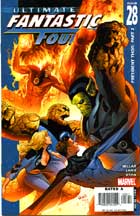 When the Fantastic Four first came on the scene, it was a revelation. While it was true that some DC titles included the problems of secondary, un-powered characters, like Jimmy Olsen, with their day to day problems, super powered individuals were above ordinary people. Not these guys. Angry, jealous, rambunctious, jocular, financially embarrassed; in short, like us, only different. When I picked up issue # 1 of the FF and Spiderman my general allegiance switched from DC to Marvel and, while that has sometimes wavered and varied over the years, I have never forgotten that moment of revelation.
When the Fantastic Four first came on the scene, it was a revelation. While it was true that some DC titles included the problems of secondary, un-powered characters, like Jimmy Olsen, with their day to day problems, super powered individuals were above ordinary people. Not these guys. Angry, jealous, rambunctious, jocular, financially embarrassed; in short, like us, only different. When I picked up issue # 1 of the FF and Spiderman my general allegiance switched from DC to Marvel and, while that has sometimes wavered and varied over the years, I have never forgotten that moment of revelation.
When one re-reads those early stories, in many ways, they don’t hold up. Some of it is Stan Lee’s writing style, verbose and florid, his dialogue contrasts strongly with the storylines and times. The stories are also fairly short. Even the Galactus epic is only 3 issues long and that is almost 5 years from the start of publication. I want to revive those feelings of surprise and excitement when reading comics. The Ultimate titles have helped.
"When I was a child I spake as a child." Read like one too. The Ultimate titles are a retake on the Marvel universe from a modern and more adult viewpoint, and I like them, generally. They do have problems. The storytelling is a little disjointed, leaving empty areas in the plot. The authors seem a little rushed at times, and skimpy on the dialogue on occasion. ( Preachy as I can be on the subject of graphic novels, it is clearly the ridiculous short length of comics that destroys the possibility of depth of plot and character development. Switch to novel length publications, guys.)
For the most part I have been quite attracted to the artwork, as most have a certain epic feeling, apropos to the situation.
All that being said, the Ultimate Fantastic Four line seems a little like a train about to run off the tracks. In issue #28 someone "dies." We all know that practically no one really dies in the comics. Even the ones that die don’t, or come back, or operate as spirits, or are reborn, or recover, or other such twisted plot devices. I’m not saying this is a bad thing, just old hat. Conversely, if this character is actually dead for the remainder of this title’s existence, then a major part of the attraction of this title has been eliminated, which seems very unlikely. The Ultimate titles should rise above hackneyed situations like this.
Then there’s the artwork. I’m sorry that I am unable to quite describe what strikes me as wrong about it, but it is wrong. The heads seem as though they are Photoshopped onto the bodies. The faces and the emotions portrayed seem like photos of bad actors, either chewing the scenery or merely posing for the camera. I hope we get through this period and everyone raises themselves back up to the quality they are capable of. In a hurry.
RATING: 
Simonson, Chaykin and Hawkgirl take over: All that glitters ain’t always gold
By Graig
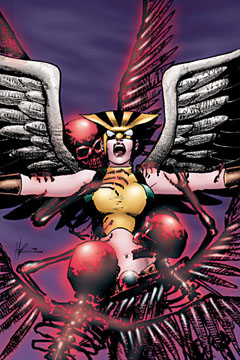 Hawkman has always been a tough sell. The frequent revamps of the character made his origins and continuity a real headache to understand, but this latest series launched by James Robinson and Geoff Johns had managed to introduce a new Hawkman, clean up his origins, and solidify his character. Johns made a good run of it, and passed the reigns on to Jimmy Palmiotti and Justin Gray who carried on admirably, further defining who Carter Hall is and his role in the DCU. Despite their quality efforts, it seems Hawkman was still a tough sell.
Hawkman has always been a tough sell. The frequent revamps of the character made his origins and continuity a real headache to understand, but this latest series launched by James Robinson and Geoff Johns had managed to introduce a new Hawkman, clean up his origins, and solidify his character. Johns made a good run of it, and passed the reigns on to Jimmy Palmiotti and Justin Gray who carried on admirably, further defining who Carter Hall is and his role in the DCU. Despite their quality efforts, it seems Hawkman was still a tough sell.
So it’s not surprising that with “One Year Later” DC has shaken things up and dropped the higher profile (because of her JLU cartoon association) Hawkgirl in the lead of the title as of issue 50. What is surprising is that two legends of comics have teamed up to take on her solo adventures. Walter Simonson handles writing chores, while Howard Chaykin takes on the art, and what’s even more surprising than their association with the title is how bad it is. Truly, it’s awful.
First, noting that this Hawkgirl is immeasurably different than the cartoon version (they killed her counterpart off in the Rann-Thanagar War), Simonson doesn’t seem to have a handle on her character at all. Kendra Saunders was introduced in JSA as a teenager, and with DC Universe aging rules, even one year later, she’s at oldest 21. So a 21 year-old with no formal degrees administrates a museum huh? His portrayal of Kendra throughout this first issue is comparative to a 1950’s romance comic heroine, with lots of overly melodramatic thought balloons (!), and about as much action and intrigue as Kathy Keene would find herself in. Hardly the grand-scale, mace-wielding, winged-warrior style action-adventure I would expect from the character. Her role in the DC Universe seems to be a simple step into Hawkman’s path, rather than defining her own. Simonson completely avoids the fact that Kendra was struggling with her identity as a reincarnated spirit, (perhaps one year later she’s resolved those feelings but there’s no indication thereof) instead having her struggle with living in the shadow of Hawkman and dealing with her feeling for a man who disappeared a year ago.
Chaykin’s art is, well, Chaykin-esque. He’s a good storyteller, but his characterization of the lead, with Kendra having big pouty lips and wistful doe-eyes, comes off very much as a romance comic lead. In the brief moments in costume, his Hawkgirl has jumped two bust sizes and seems to be really cold in her top. Hawkgirl is not a boob war vixen, man, don’t turn her into one. Chaykin’s rendering put together with Simonson’s characterization has Hawkgirl becoming a clichéd and almost insulting stereotype of what a female hero is.
The core story name-checks Indiana Jones more than once, so they seem to be going for the archaeological adventure angle, but with a character like Hawkgirl it seems a boring and unnatural fit. An uninspired and disappointing start.
RATING: 
Batman #651 is a minor disappointment
By Chris B.
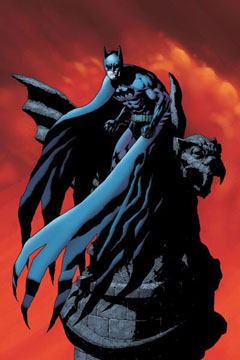 Of all the DC titles getting a “One Year Later” jumpstart, Batman needed it the least. The “Red Hood” issues were Judd Winick’s best work, as intense and darkly clever as the Bat-books had ever been. Winick gave us an increasingly tortured hero, a truly well-executed twist, and a group of fascinating villains – Jason Todd, Black Mask, and the Joker – that he could have played off each other forever.
Of all the DC titles getting a “One Year Later” jumpstart, Batman needed it the least. The “Red Hood” issues were Judd Winick’s best work, as intense and darkly clever as the Bat-books had ever been. Winick gave us an increasingly tortured hero, a truly well-executed twist, and a group of fascinating villains – Jason Todd, Black Mask, and the Joker – that he could have played off each other forever.
But the conclusion to all that stuff has presumably been left for 52, and Batman has jumped over to James Robinson’s control, for the second installment of his eight-part story “Face the Face.” The first, Detective Comics #817, was stark and masterful; you could teach a class on Batman from that issue. There’s little to no evidence of a sense of humor, but Robinson has the core of the book down cold. He writes Batman, Robin, Gordon, and Harvey Dent naturally, with a fluid confidence that escapes most writers that have tried their hand at the Bat-books. The art, by Leonard Kirk and Andy Clarke, nailed the mood as well, flooding the world with thick shadow and sharp figures, making a two-page image of Batman and Robin landing on a roof into something positively otherworldly.
So I kept thinking about that Detective Comics issue while reading the latest Batman, which is notably worse. The problems begin with the art, which suffers greatly by comparison with its sister title. Don Kramer simply doesn’t have the panache that the Detective Comics guys had. There are a couple of action sequences in the book that incorporate a string of ghostly after-images of our heroes at work, which spectacularly fail to provide an impression of coherent motion or speed; it’s just a bunch of little stiffly drawn Batmans re-arranged across a static background.
The writing, too, is more uneven than in the first installment. It’s not really fair to second-guess Robinson’s storytelling when he’s only about a quarter of the way through his story, but damn, some of this stuff stands out in the worst way. The Detective Comics issue felt like a story that had been worked through a thousand times, the essence of Gotham and a host of mysteries about the missing year shaved down to a couple dozen pages; a lot of this one feels like filler. To start, Robinson does a familiar, average-joe-on-the-street rundown of citizens realizing that Batman’s back, and liking or disliking it. While at least one is pegged as a return character, the series of glib little Gothamite summaries comes off as disinterested, a pointless reminder that yes, Batman was gone for a year and yes, things were bad in his absence, both of which were established with greater economy and force in the preceding issue.
We’re treated to the previously mentioned, decidedly un-dynamic action montages as the heroes confront Poison Ivy, who’s received some post-OYL power-up. But we don’t return to the meat of the story – the interaction between Gordon, Batman, and Robin, the murders of small-time supervillains – until the last couple of pages, and the issue is at last revealed as a big detour, a way of squeezing another big Bat-villain into a story that, at this point, is not terribly low on unresolved mysteries and questions. Batman #651 is not a bad issue, and it’s likely a good deal better than the majority of superhero books around right now, but considering the issue it’s following, and Winick’s work before the One Year Later break, it’s something of a disappointment.
RATING: 
Giffen and DeMatteis bring the yuks – perhaps too many – with Planetary Brigade
By Graig Kent
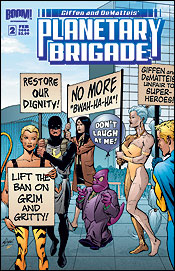
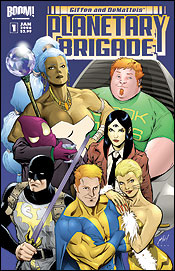 I was reading an interview a while back with Andy Helfer, who was Keith Giffen and JM DeMatteis’ editor on their Justice League run back in the 80’s. In the interview Helfer states that he would edit about thirty to forty percent of the DeMatteis’ dialogue on every page leaving only the best gags. Otherwise the artist would have nothing to draw, he jokes, as it’d be all dialogue. Until recently I didn’t realize how instrumental editing could be in the success of a book. As much as I love Giffen and DeMatteis’ recent work on JLA Classified and Defenders, it’s evident that the editors, perhaps with reverence, left the scripts comparatively untouched. It’s evident even more on Planetary Brigade, a two-part mini-series spinning off from the duo’s successful Hero Squared. The dialogue in both issues of the book flies fast and furious: witty barbs, cutting jabs and clever turns of phrase happen sometimes two or three times in the same panel. As much as it’s enjoyable, it’s also a tad overkill and too unrestrained.
I was reading an interview a while back with Andy Helfer, who was Keith Giffen and JM DeMatteis’ editor on their Justice League run back in the 80’s. In the interview Helfer states that he would edit about thirty to forty percent of the DeMatteis’ dialogue on every page leaving only the best gags. Otherwise the artist would have nothing to draw, he jokes, as it’d be all dialogue. Until recently I didn’t realize how instrumental editing could be in the success of a book. As much as I love Giffen and DeMatteis’ recent work on JLA Classified and Defenders, it’s evident that the editors, perhaps with reverence, left the scripts comparatively untouched. It’s evident even more on Planetary Brigade, a two-part mini-series spinning off from the duo’s successful Hero Squared. The dialogue in both issues of the book flies fast and furious: witty barbs, cutting jabs and clever turns of phrase happen sometimes two or three times in the same panel. As much as it’s enjoyable, it’s also a tad overkill and too unrestrained.
One of the best aspects of Giffen and DeMatteis’ partnership is their ability to balance humor with drama and action, their adeptness at infusing personality into their characters and quickly defining the cast dynamic. In Planetary Brigade the dialogue and humor overwhelm all the other aspects. Since we only ever got a taste of the superteam in Hero Squared, I was hoping for something more revealing here, alas, it seems aside from Captain Valor and the Grim Knight, the remaining cast after two issues are still just unknown wisecrackers. The heart that the pair normally inject in their books turns up in the final pages of the second issue, but it’s just not a big enough aspect.
If an overabundance of witty dialogue were the books only problem, well, there are worse things. Alas, through 48 pages of story they run through no less than 8 artists, so visual consistency also becomes a highly distracting matter. In instances where a book is team drawn, a good colorist can unify the book, but Pilvi of Imaginary Friends Studio uses soft and muddy tones that just aren’t very attractive.
It feels almost blasphemous to put down a book by the duo that created my favorite comic series ever, and perhaps I am being unduly harsh, because at the same time, even with all the difficulties I had with it, I still found much to enjoy in it.
![]()

New Warriors: Reality Check TPB
(Marvel)
By Dave Davis
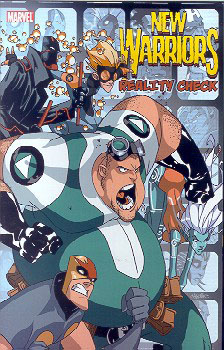 I have a pretty fuzzy recollection of The New Warriors in their early-90s incarnation – if memory serves, it was basically a team book stuffed with crappy D-list characters like Speedball and Nova and possibly Darkhawk, led by a rich kid called Night Thrasher who was basically a skateboarding aggro-Batman who hit people with police batons.
I have a pretty fuzzy recollection of The New Warriors in their early-90s incarnation – if memory serves, it was basically a team book stuffed with crappy D-list characters like Speedball and Nova and possibly Darkhawk, led by a rich kid called Night Thrasher who was basically a skateboarding aggro-Batman who hit people with police batons.
Marvel has revived The New Warriors for a 21st century version (along with just about every other character from their vaults — Marvel’s monthly solicitation list is cluttered with more unnecessary rubbish than at the height of the speculator market), but given it a distinctive and surprisingly entertaining twist. Reality Check starts in Blues Brothers “putting the band back together” fashion, with Thrasher collecting members of the defunct team. The bouncy motormouth Speedball, generic helmeted hero Nova, and Sub-Mariner’s cousin Namorita (who now has blue skin and tattoos and looks like she escaped from Disney’s animated feature Atlantis), and albatross Microbe, an overweight social misfit who can communicate with germs.
The hook here is that the reassembled team (or the now-bankrupt Thrasher, anyway) has agreed to travel the country fighting super-crime in small towns while their heroics are captured by a TV crew for a new reality series. When their clashes with low-tier supervillains like Tiger Shark and talking zoo animals don’t yield big ratings, the network suits throw in some drama by adding a sassy new team member named Debrii, who can telekinetically manipulate garbage.
With the cartoonish proportions and madcap conflicts and facial expressions in that ubiquitous manga-inspired cel-shaded style that looks like screen-grabs from an animated series, the book is obviously trying to emulate the successful Teen Titans show. But it also finds an identity and personality its own thanks to artist Scottie Young’s lively characters and kinetic action, and writer Zeb Well’s balance of quips, sharp satire and sincerity. Despite the minor league characters, this initial arc of the latest New Warriors volume is easily accessible and certainly worthwhile – I wish the same could be said for 95% of Marvel’s current output.
RATING: 
A Family Secret TPB
(Anne Frank House)
By Mark Wheaton
 Eric Heuvel’s quiet, first-person oral history, A Family Secret uses Tintin-like artwork and an easy, conversational voice to tell a story of a young man who – while searching through an attic – learns the story of the Nazi occupation of the Netherlands as told in remembrances from his grandmother.
Eric Heuvel’s quiet, first-person oral history, A Family Secret uses Tintin-like artwork and an easy, conversational voice to tell a story of a young man who – while searching through an attic – learns the story of the Nazi occupation of the Netherlands as told in remembrances from his grandmother.
While yes, the literature about the Holocaust is vast – even in the comics world with Art Spiegelman’s groundbreaking Maus – A Family Secret doesn’t try to cover the whole war from every point-of-view and that is its strength. Instead of illustrating the entire story of the Nazi’s persecution of the Jews, Heuvel instead describes the occupation of Holland through the eyes of a teenage girl with a Jewish best friend as they both come of age during the war years. Though the art and point-of-view suggest something aimed at children (with echoes of Anne Frank’s Diary of a Young Girl), Heuvel doesn’t flinch when describing the horrors of the Holocaust and the hardships faced by the Dutch people.
Interestingly enough, rather than painting the protagonist as some sort of saint among sinners, the grandmother – Helena – is saddled with a brother who initially rebels against the crushing abuses of the Nazis, but eventually joins the German army to get away from his family life, only to die on the Russian front. Helena’s other brother, Wim, joins the resistance and is almost killed time and time again and similarly has to leave home for the same reason as his eldest brother – their father. Helena’s dad, a city police officer at the beginning, ends up collaborating with the Nazis and helping them round up the Jews. This thread, particularly in how Helena and her mother regard his betrayal of his own values, is the strongest of the book.
Instead of familiar, over-used “types,” A Family Secret gives us very real examples of people suffering through war. The father could’ve easily been a harsh stereotype who drove his son to the Russian front and fell for the charisma of the Nazis. Instead, he’s a man who – ultimately – is simply trying to survive the war and preserve his family the best way he knows how. On the last page of the book, we’re shown his true colors and – because Heuvel has taken the time to round out all his characters – it hits the reader like a hammer.
Frankly, A Family Secret is the kind of book that very few will end up reading, but is a great piece of history. Too often for kids, historical events can feel too big and incomprehensible when strewn through thick books or conversely, three paragraphs in a textbook will never fully relate the human side of any big story. A Family Secret, on the other hand, shuns big, overarching storytelling and, instead, illustrates its tale in a wholly human and dimensional fashion.
RATING: 
![]()

 Nextwave #3 (Marvel) – On an issue-by-issue basis, there’s probably not going to be a lot to say about writer Warren Ellis’ latest series: spandex snark, silly monsters, bickering teammates, and a boatload of “British-ism’s” to wow the colonials. Fun stuff. What is worth commenting on, every time out, is Stuart Immonen’s art: the guy is abso-freakin-lutely NAILING this book. I’m not sure there’s a more versatile artist working today, and he’s streamlined his style (even from his recent Ultimate X-Men run) into something so fluid and vibrant that it makes most of today’s superhero throwdowns look outright stodgy by comparison. He’s ably abetted by the inking of Wade Von Grawbadger, and the eye-popping coloring of Dave McCaig. I don’t know how long Marvel will stand behind this book (a common theme this week, actually), or whether it will start to feel like a case of diminishing returns at three bucks a pop; but as long as Immonen stays on it, it’s going to be worth a look. – Jeb D.
Nextwave #3 (Marvel) – On an issue-by-issue basis, there’s probably not going to be a lot to say about writer Warren Ellis’ latest series: spandex snark, silly monsters, bickering teammates, and a boatload of “British-ism’s” to wow the colonials. Fun stuff. What is worth commenting on, every time out, is Stuart Immonen’s art: the guy is abso-freakin-lutely NAILING this book. I’m not sure there’s a more versatile artist working today, and he’s streamlined his style (even from his recent Ultimate X-Men run) into something so fluid and vibrant that it makes most of today’s superhero throwdowns look outright stodgy by comparison. He’s ably abetted by the inking of Wade Von Grawbadger, and the eye-popping coloring of Dave McCaig. I don’t know how long Marvel will stand behind this book (a common theme this week, actually), or whether it will start to feel like a case of diminishing returns at three bucks a pop; but as long as Immonen stays on it, it’s going to be worth a look. – Jeb D.
RATING: 
 Black Panther #14 (Marvel) – After two issues of vampire ass-kicking, issue #14 begins the “Bride of the Panther” arc by telling the beginnings of T’Challa’s relationship with a young Ororo Munroe many years before in Africa. While focusing more on Storm’s origins than T’Challa, her story is just as fascinating and well-told. Though T’Challa left her to avenge his father’s murder, many years later, he has realized his mistake and wants her back. Despite “Bride of the Panther” promising to be less than an action yarn, writer Reginald Hudlin’s expansion of Storm’s backstory is quite well-done. On top of that, the brief encounter between the Black Panther and Wolverine suggests a history together that is too tantalizing not to be expanded upon. While not the best Black Panther adventure, at least it looks like “Bride of the Panther” will make for a diverting interesting tale. – Mark
Black Panther #14 (Marvel) – After two issues of vampire ass-kicking, issue #14 begins the “Bride of the Panther” arc by telling the beginnings of T’Challa’s relationship with a young Ororo Munroe many years before in Africa. While focusing more on Storm’s origins than T’Challa, her story is just as fascinating and well-told. Though T’Challa left her to avenge his father’s murder, many years later, he has realized his mistake and wants her back. Despite “Bride of the Panther” promising to be less than an action yarn, writer Reginald Hudlin’s expansion of Storm’s backstory is quite well-done. On top of that, the brief encounter between the Black Panther and Wolverine suggests a history together that is too tantalizing not to be expanded upon. While not the best Black Panther adventure, at least it looks like “Bride of the Panther” will make for a diverting interesting tale. – Mark
RATING: 
 The American Way #2 (Wildstorm) – Last month, The American Way started off with a rather shocking premise – that the silver age superhero teams were, in fact, the results of staged performances between a cast of “good guys” and “bad” used to keep the American peoples’ attention turned from the nation’s real problems. In issue #2, following the death of the team’s all-American leader (the minuteman-dressed Old Glory), the series’ real thrust comes forward – the creation of Old Glory’s replacement, a black Captain America meant to help deal with the civil rights movement. Furiously cursing the fact that he has to wear a mask at first to hide his race, Jason Fisher makes for an unlikely super-soldier, but with this sort of backdrop, writer John Ridley is obviously going for something out of the ordinary. So far, it’s not the best comic out there, but #2 could be the weak, exposition-heavy second issue that’s then followed by a truly compelling story. – Mark
The American Way #2 (Wildstorm) – Last month, The American Way started off with a rather shocking premise – that the silver age superhero teams were, in fact, the results of staged performances between a cast of “good guys” and “bad” used to keep the American peoples’ attention turned from the nation’s real problems. In issue #2, following the death of the team’s all-American leader (the minuteman-dressed Old Glory), the series’ real thrust comes forward – the creation of Old Glory’s replacement, a black Captain America meant to help deal with the civil rights movement. Furiously cursing the fact that he has to wear a mask at first to hide his race, Jason Fisher makes for an unlikely super-soldier, but with this sort of backdrop, writer John Ridley is obviously going for something out of the ordinary. So far, it’s not the best comic out there, but #2 could be the weak, exposition-heavy second issue that’s then followed by a truly compelling story. – Mark
RATING: 
 Fused Tales # 1 (Boom Studios) – It’s “Concrete Meets Robotman Meets Hellboy Meets Frankenstein.” A terrific book with a protagonist who is a young robotics engineer whose body has become fused with a robot suit during a routine experiment. This issue has three stories written by three different authors and drawn by three different artists, each story with its own charm. Mark, our hero, meets terrorists, a Lovecraftian creature, and his ex-wife. Each part seems familiar yet surprising, offering a different take on a bizarrely matter-of-fact sort of viewpoint. – Elgin
Fused Tales # 1 (Boom Studios) – It’s “Concrete Meets Robotman Meets Hellboy Meets Frankenstein.” A terrific book with a protagonist who is a young robotics engineer whose body has become fused with a robot suit during a routine experiment. This issue has three stories written by three different authors and drawn by three different artists, each story with its own charm. Mark, our hero, meets terrorists, a Lovecraftian creature, and his ex-wife. Each part seems familiar yet surprising, offering a different take on a bizarrely matter-of-fact sort of viewpoint. – Elgin
RATING: 
 Ares #3 (Marvel)- Marvel’s editorial department is currently going through a period of really interesting diversity, and I’d feel more encouraged by that if I thought that management was really buying into it. Here’s a very nice miniseries, with an interesting new protagonist, great father-son dynamic, sharp plotting and dialog from Mike Oeming, and gorgeous art from Travel Foreman (leaps and bounds past his work on Star Wars or Doctor Spectrum), and I’m guessing it will be only sheer luck (or inattention by the accounting folks) that keeps it running for its scheduled five issues. I just don’t see today’s comic marketplace supporting this kind of “niche” series (at least at the level that Marvel would deem acceptable) and that’s too bad; if this was an “indie” book, it’d be a great success story. Anyway, for anyone who’s thinking of getting onboard, Ares, God of War, has lost his chance to leave Olympus behind and raise his son in peace: his son’s been taken, everything’s gone to hell, and he’s become a reluctant ally of his estranged father, Zeus, and the remaining Olympian gods and heroes in their last stand against an apparently unstoppable foe. The “guns-versus-the-gods” stuff continues to be great fun, and it looks like the last two issues will be wall-to-wall mayhem. Here’s hoping they come out. –Jeb D.
Ares #3 (Marvel)- Marvel’s editorial department is currently going through a period of really interesting diversity, and I’d feel more encouraged by that if I thought that management was really buying into it. Here’s a very nice miniseries, with an interesting new protagonist, great father-son dynamic, sharp plotting and dialog from Mike Oeming, and gorgeous art from Travel Foreman (leaps and bounds past his work on Star Wars or Doctor Spectrum), and I’m guessing it will be only sheer luck (or inattention by the accounting folks) that keeps it running for its scheduled five issues. I just don’t see today’s comic marketplace supporting this kind of “niche” series (at least at the level that Marvel would deem acceptable) and that’s too bad; if this was an “indie” book, it’d be a great success story. Anyway, for anyone who’s thinking of getting onboard, Ares, God of War, has lost his chance to leave Olympus behind and raise his son in peace: his son’s been taken, everything’s gone to hell, and he’s become a reluctant ally of his estranged father, Zeus, and the remaining Olympian gods and heroes in their last stand against an apparently unstoppable foe. The “guns-versus-the-gods” stuff continues to be great fun, and it looks like the last two issues will be wall-to-wall mayhem. Here’s hoping they come out. –Jeb D.
RATING: 
 Giant Monster # 1 & # 2 (Boom Studios) – Do you like Godzilla? How about zombies? What if I threw in a gigantic Nazi robot and stirred up everything with a big stick then poured it all over downtown Los Angeles? Well, Steve Niles and Nat Jones have already done this for you in these two issues, and they are a fun couple of books; nothing very deep, but exciting and gooey. – Elgin
Giant Monster # 1 & # 2 (Boom Studios) – Do you like Godzilla? How about zombies? What if I threw in a gigantic Nazi robot and stirred up everything with a big stick then poured it all over downtown Los Angeles? Well, Steve Niles and Nat Jones have already done this for you in these two issues, and they are a fun couple of books; nothing very deep, but exciting and gooey. – Elgin
RATING: 
 Sable and Fortune #3 (Marvel) – By the way, that’s now “#3 of 4”, not “#3 of 6” as
Sable and Fortune #3 (Marvel) – By the way, that’s now “#3 of 4”, not “#3 of 6” as
